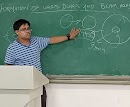Quantum Harmonic Oscillator Part-1: Introduction in a Nutshell
Well, Quantum Harmonic Oscillator is one such topic. Fancy name with
fancy application.
The goal of this article is to give a solid foundation in this topic.
I will try my best to make you understand this concept and give you the essence
of it rather than only spitting out some random equations and their derivations
like most textbooks and online sites do, after-all, this the motto of our
website.
So, let’s start….
To understand the Quantum Harmonic Oscillator, firstly we have to have
an idea on the classical harmonic oscillator and the basic meaning of Harmonic
motion.
Harmonic Motion and Classical Harmonic Oscillator
The harmonic motion refers to the periodic motion or periodic vibration. To
understand it better, just imagine a string of a guitar is vibrating, then those
motions are symmetrical about a region of equilibrium and distance of each trough
and crest from the median line is same when a continuous force of same amount is
applied. This type of motions may have a single frequency or amplitude or may
be composed of two or more such simple type of motions.
Classical Harmonic Oscillator refers to a system which if displaced
from the equilibrium, experiences a force named as restoring force. This force
is proportional to the displace x. The whole system can be imagined like an
object with mass m is attached with the spring, and when the spring vibrates it
created a graph with uniform tough and crest.
If that force is the only force acting on the system then the system is called as Simple Harmonic Oscillator and the motion it shows us is called Simple Harmonic motion (SFM) and the equation of force in that case is
F = -kx (-∞ ≤ x ≥ ∞ ) (1)
Where, F and X are vectors and k (spring constant) is a positive
constant
Here in the above equation, the negative sign refers to the opposite
direction of the motion as compared to the direction of the force applied.
Before starting our discussion about the quantum harmonic oscillator,
we need to know a couple of more formulae and concepts…
The time period (period after which the motion repeats itself) for the
simple harmonic motion is
T
= 2π√(m/k) (2)
Where, m is the mass of the object undergoing the SHM and k is the
spring constant
One thing which we should keep in mind that SHM is not damped motion.
A damped motion is such kind of motion which dies after a period of time. In the reality most of the motions and oscillations are damped unless and until they
are given some sought of force or energy. Discussing further about the
formulation and derivations on the damping motion is beyond the scope of this
article.
Another formula related to classical harmonic oscillator is the solution of the differential equation of (1),
x(t) = A cos(ωt + φ) (3)
where, A is amplitude of the wave, ω is the angular
frequency and φ is the phase.
Here, ω = √(k/m) and thus eq. (2) can be written as T= 2π/ ω
Also, to get into the Schrodinger’s
equation and related it to harmonic oscillation, we need to get the expression
for potential, so let’s get it,
V(x) = -ഽF dx
= ഽkx dx
= kx²/2 + c (4)
Where, c
is the constant of integration
Note here
the use of negative during integration. Here, its use to denote the opposite
direction of potential energy stored as compared to the direction of force
applied.
Equation 4
is also named as Harmonic oscillator potential.
The value
of c is normally dropped in the further calculation for the sake of simplicity
and also because it doesn’t change the final value drastically.
Quantum
Harmonic Oscillator
Here we
go, finally in the fun part….
As you
know, Quantum Harmonic Oscillator (QHO) is a very vast topic. In fact, it’s one
of the few topics in QM for which an analytic and exact solution is known to
us. That makes this topic one of the key systems to study QM.
QHO is the
quantum mechanical version of classical harmonic oscillator and that’s why I
preferred to give a brief intro to the topic.
So, lets
start from forming Schrodinger’s equation,
So, by
putting equation 4 in Schrodinger’s equation, we get,
-
(ħ²/2m)(d² 𝜓ₙ/dx²) + kx²/2 𝜓ₙ = Eₙ 𝜓ₙ (5)
This equation will be used in my future articles on this topic.
Since I
am intended to write this article as an introductory article to QHO, so I will
not go further deep into the formulation on this topic, rather I like to give you
a brief overview of it. In future posts, I will tackle each and every
necessary topic under QHO.
Now, here
I want to introduce you the applications of Quantum Harmonic Oscillator theory:
1) It can
be used to describe the vibration spectra of diatomic molecules and complex
modes of vibration in larger molecules
2) It is
used in the theory of vibrational heat capacity
3) I can
be used to understand the motion of atoms in solid lattice and explains who
phonons arise from them. In the periodic and elastic arrangement of atoms or
molecules of condensed matter (solids and some special liquids), if any
collective excitation happens then that called as a Phonon. Using QHO, we can
find various properties regarding that, for example, we can find the exact amount of
energy, which if supplied to the QHO lattice then it can push it to the next
energy level.
4) It can
also, be useful to find the expression for thermodynamic vibrational energy.
In my further articles, I will try to tackle each and every necessary topic which are needed to understand QHO. In part 2 of QHO series, I will explain Schrödinger's equation with dimensionless terms. On the basis of that article, I will try to explain the Asymptotic Solution of QHO. Once they are uploaded, the links will be provided here.
-Ratnadeep Das Choudhury













0 Comments